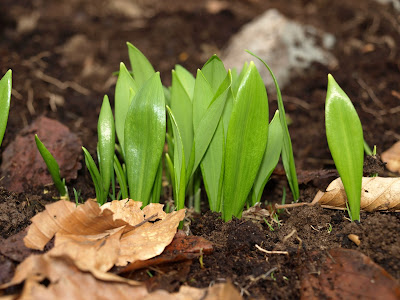Finding wild plants
Wild food is absolutely everywhere. There are hundreds of edible wild plants in the British Isles. Wild plants grow in most back gardens, particularly those that haven't been weeded to within an inch of their sad and sorry little lives. Wild plants are itching to come up in all sorts of unlikely places and they will colonise anywhere from a lawn to a crack in the pavement.
 |
| Wild garlic available now in the UK for foraging or grow your own |
The easiest way to find wild plants without spending the weekend trekking over half of the New Forest (although this does sound good) is to leave an area of the back garden untouched. Spring or summer are the best times to try this. If no wild plants come up (unlikely) then they can be grown from seed obtained from mail order companies. These plants will still be as good. However, unless the soil has been sterilised (unlikely), badly contaminated (possible) or completely destroyed (unlikely but possible), it will have wild plant seeds or roots in situ just waiting for the opportunity to grow.
Foraging guidelines
Use basic common sense when picking wild plants. The most important thing to do is to correctly identify the plant. If using reference books, use at least two or three photographs and remember that plants don't look the same all year round. There are plenty of photographs of wild plants available online. Also check out wild flower and wild food books. First timers, untrained in the art of identification, maybe shouldn't risk picking plants like Queen Anne's lace (Daucus carota) because of its resemblance to hemlock (Conium maculatum), which is poisonous.
Always use the Latin name in conjunction with, or instead of, common names. Latin names are usually italicised and listed here in brackets. A Latin name will correctly identify the plant required. The same local or common name can be used for many different plants so it can make identification very difficult. Cleavers (Galium aparine) is also known as clivers, goose grass, beggar's lice, cleaverwort, everlasting friendship, grip grass, scratch grass, stick-a-back, sticky willie, sticky willy, scarthgrass, white hedge and catchweed bedstraw. Enough said.
Always take care when foraging that plants have not been contaminated by chemicals, human sewage, animal manures or any other nasty. This advice is more important outside the controlled environment of a private garden. Do not, for example, pick anything from alongside busy roads where exhaust fumes have polluted everything in sight. Also be careful of industrial sites where any type of chemical or other contaminant could have been spilled. Beware of woodland edges that border onto ploughed farmland as they could have been caught by chemical spray drift. If there is the slightest hint of any chemicals or other contaminants being used anywhere near wild plants, do not pick them.
Avoid picking dodgy, diseased, dying or dead foliage and certainly don't eat it. Dodgy means anything that doesn't look or 'feel' entirely right (OK I made that up but it still applies). Diseased plant material may have coloured (usually not green!) patches or spots. Typically yellow and red before going grey, brown or black. Dead foliage will be dry and crispy. Do not ingest.
Forage for flowers, fruit, fungi or foliage only. Don't uproot plants or destroy plants. Removing roots may kill a plant. Also, certain wild plants are rare and protected so should not be touched for obvious reasons. Try to avoid taking too many or any annual flowers as these provide the seed stock for next year's plants. Pick all wild plants in moderation and leave plenty, particularly for the wildlife who live there. Don't repeatedly strip the same area time and again. Don't disturb dead wood, break branches, trample the ground or destroy anything. Don't leave litter behind and take any litter away, regardless of who it belongs to. Be respectful and quiet. Do not disturb the wildlife. Take delight in the natural environment. Close gates.
Check what Laws apply to the area being foraged. Get permission if needs be, particularly if foraging on private land. Anything taken from private land without permission could be considered theft. However, private landowner's may be happy to allow foraging for a share of the booty.
Growing our own
If it isn't practical to go foraging, the plants in this book can be grown at home. One of the best ways is by using a plant-based system called vegan-organic (or stockfree organic) cultivation. Vegan organics avoids the use of artificial chemicals, genetically modified material (GMOs) and all animal products such as manure, blood, bonemeal, fishmeal and feathers.It is carbon neutral and climate friendly, supporting wildlife and providing a long-term sustainable way of producing food. Aplant-based agricultural system like this can feed far more people than that based on meat, milk and other animal products.
How do we enrich the soil if we don't use manure and other animal products? Plants feed the soil themselves without needing to pass through an animal first. Soil fertility originates from plants and can be maintained and even increased by using certain methods of plant-based cultivation such as crop rotation, mulching, composting, by using green manures and seaweed meal (not calcified)
This is an excerpt from Raw Edible Wild Plants for the British Isles (& other places too) by Amanda Rofe. Chapter 2. Foraging and growing. Published on Amazon Kindle £2.50 or free on Kindle Unlimited.